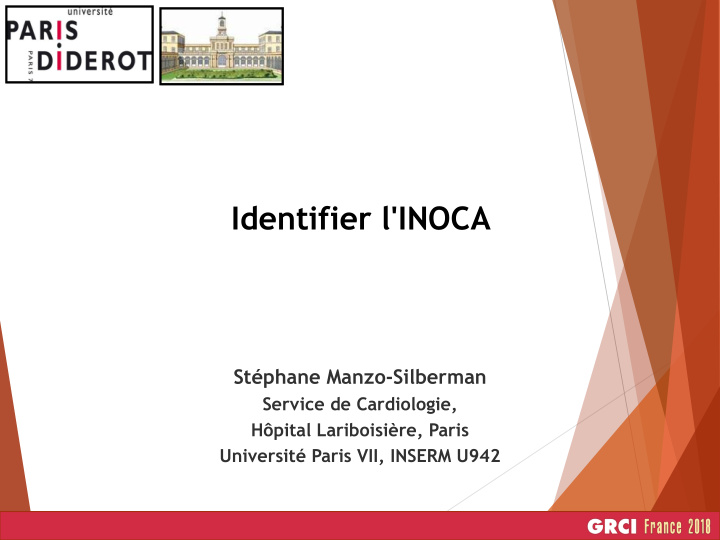



Identifier l'INOCA Stéphane Manzo-Silberman Service de Cardiologie, Hôpital Lariboisière, Paris Université Paris VII, INSERM U942
DÉCLARATION DE LIENS D'INTÉRÊT AVEC LA PRÉSENTATION Intervenant : Stéphane MANZO-SILBERMAN, Paris ☑ Je n'ai pas de lien d'intérêt lié à la présentation à déclarer
Background • Last decades focus on obstructive coronary artery disease • Non obstructive coronary artery disease (NOCAD) • 21-46% in stable angina 1-3 • 11-16% in NSTEMI • 1-14% in MINOCA • 60% due to coronary microvascular dysfunction • Underestimated problem Patients are often wrongfully reassured, while chest pain symptoms lead to 4,5 : • Higher mortality • Anxiety Limited physical activity • Reduced quality of life • • Higher rate of repeated procedures and medical 1) Jespersen, L., et al., EHJ, 2012 assessment 2) Patel, M.R., et al., NEJM, 2010 3) Sedlak, T.L., et al., Am Heart J, 2013 • Higher healthcare cost 4) Johnson, B.D., et al., Circulation, 2004 5) Olson, M.B., et al., EHJ, 2003
Quizz: Diagnostiquer les INOCA Impossible, ca n’existe pas! 1. En pratique aucun interêt: il n’y a pas de traitement 2. C’est faisable en pratique courante invasive 3. C’est faisable en pratique courante non invasive 4.
INOCA MINOCA Epicardial spasm Epicardial spasm Microvascular dysfunction Microvascular dysfunction Spontaneous coronary artery dissection (SCAD) Takotsubo Pulmonary embolism Systemic disease Myocarditis Higher prevalence in women MINOCA = myocardial infarction with NOCAD Courtesy of Yolande Appelman
Coronary obstruction Coronary evaluation Coronary angiogram CTscan Classification: 0-20%: normal 20-50%: non obstructive : NOCAD 50- 70% + inducible Ischemia or FFR ≤ 0.8: Obstructive ischemia ≥ 70: obstructive CAD 1) Andersson HB., et al., EHJ, 2018 2) Dehmer GJ., et al., JACC,2012 3) Douglas PS., et al., JACC, 2011 4) Patel MR, et al., J Nucl Cardiol, 2017 5) Kohl P., et al., Eur J Cardiothorac Surg, 2014
Herscovici R et al. JAHA 2018
Definition of CMD Definite: patients presenting with angina pectoris or ischemic-like symptoms in the absence of flow-limiting CAD with both objective evidence of myocardial ischemia and CMD. Suspected: patients presenting with angina pectoris or ischemic-like symptoms in the absence of flow-limiting CAD with objective evidence of myocardial ischemia or evidence of impaired CMD alone. 1) Chen, C., Circ J, 2017 Review on epidemiology, pathogenesis, prognosis, diagnosis, risk factors and therapy
Ford TJ., et al., EHJ, 2018
Functional testing Invasive testing Coronary Blood Flow and epicardial artery diameter Endothelium – dependent probes: Acetylcholin , bradykinin… Exercise, mental-stress, cold pressor test Coronary Flow reserve Endothelium-independent probes: adenosin, nitroglycerin Doppler flow wire Thermodilution wire IMR Acetylcholine test for coronary microvascular spasm Coronary slow flow phenomenon (TIMI frame count) Safe: no death, <1% procedure related adverse experiences IVUS/ OCT ---- MINOCA 1) Lee BK., et al., Circ, 2015 2) Ong P., et al., Circ, 2014 3) Wei J., et al., JACC Cardiovasc Interv 2012
Functional testing Non-Invasive testing PET Positron emission tomography: Reproductible evaluation of CBF Evaluation Myocardial perfusion, LV function CFR Transthoracic Echo Doppler Coronary flow velocity (CFV) of the LAD rest = dypiridamole 20% INOCA : reduced CFV reserve < 2.0 Low CFV reserve : greater symptoms and limitations cMRI Subendocardial perfusion: Myocardial perfusion reserve index Adenosin stress : 63% abnormal Native T1 mapping and perfusion reserve index 1) Taqueti VRet al., Circ, 2015 2) Mygind ND., et al., JAHA 2016 3) Lanza GA, et al., JACC , 2008 4) Thomson LE., et al., Circ Cardiovasc Imaging, 2015 5) Shaw JL., Int J Cardiol., 2018
Coronary microvascular dysfunction Spasm CFR (& IMR) CFR < - 2.5 Non-invasive Acetylcholine IMR > 25 - PET reactivity - TTE test - CMR Invasive - Doppler - Thermodilution FFR = fractional flow reserve CFR = coronary flow reserve IMR = index of microvascular resistance
Coronary microvascular dysfunction Spasm CFR < - 2.5 Acetylcholine IMR > 25 reactivity test FFR = fractional flow reserve CFR = coronary flow reserve IMR = index of microvascular resistance
How to diagnose CMD Invasive tests: Non-invasive tests: We’re not there yet: CFR • PET Doppler flow wire • CMR • Thermodilution wire • No accurate golden standard • CMR SPECT • HMR • No recommendations in current guidelines TTDE • IMR • Unknown impact of age and sex Acetylcholine test for coronary microvascular spasm • MCE Coronary slow flow phenomenon (TIMI frame count) • PET = Positron Emission Tomography TTDE = Trans Thoracic Doppler Echocardiography CFR = Coronary flow reserve CMR = Cardiac Magnetic Resonance MCE = Myocardial Contrast Echocardiography IMR = Index of microvascular resistance SPECT = Single-Photon Emission Computed HMR = Hyperemic index of microvascular resistance Tomography Courtesy of Yolande Appelman
Prevalence of CMD Variable between 22-64% 1 Due to heterogeneity in Definition Inclusion criteria Cut-off values Imaging modalities 1) Chen, C., Circ J, 2017 Review on epidemiology, pathogenesis, prognosis, diagnosis, risk factors and therapy
Invasive evaluation of NOCAD in 139 patients 44% Prevalence 21% 23% 7% 5% 1) Lee et al. Circulation 2015
Impact of CMD Pacheco Claudio ., et al., Clinical Cardiol, 2018
Risk factors and CMD Similar to the traditional risk factors of obstructive CAD Smoking We’re not there yet: Diabetes Aging • No accurate figures from trials Hypertension • Unknown impact of age and sex High LDL • Unknown impact of depression and stress Systemic inflammation • Unknown impact of female specific risk factors • Unknown impact of hormonal changes 1) Brainin, P., et al, Inter J of Cardiol, 2018 systematic review and meta-analysis on prognosis
Risk evaluation Herscovici R et al. JAHA 2018
Limits Herscovici R et al. JAHA 2018
Appelman Y., Eurointervention, 2018
Recommend
More recommend